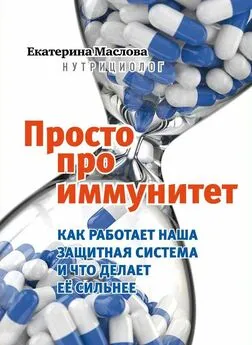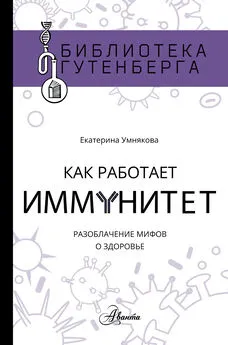Екатерина Умнякова - Как работает иммунитет [litres]
- Название:Как работает иммунитет [litres]
- Автор:
- Жанр:
- Издательство:Литагент АСТ
- Год:2019
- Город:М.
- ISBN:978-5-17-112323-9
- Рейтинг:
- Избранное:Добавить в избранное
-
Отзывы:
-
Ваша оценка:
Екатерина Умнякова - Как работает иммунитет [litres] краткое содержание
Для широкого круга читателей.
Как работает иммунитет [litres] - читать онлайн бесплатно ознакомительный отрывок
Интервал:
Закладка:
Okada H., Kuhn C., Feillet H., Bach J-F. The ‘hygiene hypothesis’ for autoimmune and allergic diseases: an update. // Clin Exp Immunol. 2010. Vol. 160, № 1. P. 1–9.
Джессика Снейдер Сакс. «Микробы хорошие и плохие» М.: АСТ: CORPUS, 2014. – 496 c.
Gell P.G.H., Coombs R.R.A. The classification of allergic reactions underlying disease. // Clinical Aspects of Immunology. BlackwellScience. 1963
Рёкен М., Гроверс Г., Бургдорф В.; Пер. с англ. Наглядная аллергология. М.: Бином. Лаборатория знаний. 2018, – 238 с.
Janeway C., Jr, Travers P., Walport M., Shlomchik M. Immunobiology, 5th edition. The Immune System in Health and Disease. New York: Garland Science; 2001.
Janeway C., Jr, Travers P., Walport M., Shlomchik M. Immunobiology, 5th edition. The Immune System in Health and Disease. New York: Garland Science; 2001.
Basu S., Kaur R., Kaur G. Hemolytic disease of the fetus and newborn: Current trends and perspectives. // Asian J Transfus Sci. 2011. Vol. 5, № 1. P. 3–7.
Stone S.F., Phillips E.J., Wiese M.D., Heddle R.J., Brown S.G.A. Immediate-type hypersensitivity drug reactions. // Br J Clin Pharmacol. 2014. Vol. 78, № 1. P. 1–13.
Kumar V. K., Abbas A. K., Aster J.C. Hypersensitivity: immunologicaly mediated tissue injury. Robbins & Cotran Pathologic Basis of Disease (9th ed.). Elsevier Health Sciences. 2014. P. 200–211.
Шенфельд И., Мерони П.Л., Чурилов Л.П… Руководство по аутоиммунным заболеваниям для врачей общей практики; пер. с англ. СПб.: Элби-СПб. 2017, – 416 с.
Uzzaman A., Cho S.H.Chapter 28: Classification of hypersensitivity reactions. // Allergy Asthma Proc. 2012. Vol. 33, Suppl 1. P. 96–99.
Orme I.M., Andersen P., Boom W.H. T cell response to Mycobacterium tuberculosis. // J Infect Dis. 1993. Vol. 167. P. 1481–1497.
Encinales L., Zuñiga J., Yunis M., Granados-Montiel J., Granados J., Almeciga I., Clavijo O., Awad C., Collazos V., Vargas-Rojas M.I., Bañales-Mendez J.L., Vazquez-Castañeda L., Stern J.N., Romero V., Frindkis-Hareli M., Terreros D., Fernandez-Viña M., Yunis E.J. Humoral immunity in tuberculin skin test anergy and its role in high-risk persons exposed to active tuberculosis. // Mol Immunol. 2010. Vol. 47, № 5. Article 1066.
Palm N.W., Rosenstein R.K., Medzhitov R. Allergic host defences. // Nature. 2012. Vol. 484, № 7395. P. 465–472.
Мечников И.И. «Этюды оптимизма» М.: Наука, Главная редакция литературы на ин. яз., 1988. – 328 с.; Мечников И.И. «Этюды о человеческой природе» СПб.: Азбука, Азбука-Аттикус, 2016. – 320 с.
Hillman E.T., Lu H., Yao T., Nakatsu C.H. Microbial ecology along the gastrointestinal tract // Microbes Environ. 2017. Vol. 32, № 4.P. 300–313.
Hillman E.T., Lu H., Yao T., Nakatsu C.H. Microbial ecology along the gastrointestinal tract // Microbes Environ. 2017. Vol. 32, № 4.P. 300–313.
TanakaM., Nakayama. Development of the gut microbiota in infancy and its impact on health in later life // J. Allergology International. 2017. Vol. 66, № 4. P. 515–522; Ramakrishna B.S. Role of the gut microbiota in human nutrition and metabolism // J Gastroenterol Hepatol. 2013. Vol. 28, № 4. P.9–17
Hillman E.T., Lu H., Yao T., Nakatsu C.H. Microbial ecology along the gastrointestinal tract // Microbes Environ. 2017. Vol. 32, № 4.P. 300–313.
Джессика Снейдер Сакс. «Микробы хорошие и плохие» М.: АСТ: CORPUS, 2014. – 496 c.
Sanders M.E., Guarner F., Guerrant R., Holt P.R., Quigley E.M., Sartor R.B., Sherman P.M., Mayer E.A. An update on the use and investigation of probiotics in health and disease // Gut. 2013. Vol. 62 № 5: 787–796.
Degnan F.H. The US Food and Drug Administration and probiotics: regulatory categorization // Clin Infect Dis. 2008. Vol. 46, № 2: S133-136; discussionS144–151.
Hill C., Guarner F., Reid G., Gibson G.R., Merenstein D.J., Pot B., Morelli L., Canani R.B., Flint H.J., Salminen S., Calder P.C., Sanders M.E.Expert consensus document. The International Scientific Association for Probiotics and Prebiotics consensus statement on the scope and appropriate use of the term probiotic. // Nat Rev Gastroenterol Hepatol. 2014. Vol. 1, № 8. P. 506–514.
Джессика Снейдер Сакс. «Микробы хорошие и плохие» М.: АСТ: CORPUS, 2014. – 496 c.
Eberl G., Lochner M. The development of intestinal lymphoid tissues at the interface of self and microbiota // Mucosal Immunol. 2009. Vol. 2, № 6. P. 478–485.
Jung C., Hugot J-P., Barreau F. Peyer’s patches: the immune sensors of the intestine // Int J Inflam. 2010; Vol. 2010. Article 823710.
Hemarajata P., Versalovic J.Effects of probiotics on gut microbiota: mechanisms of intestinal immunomodulation and neuromodulation // Therap Adv Gastroenterol. 2013. Vol. 6, № 1. P. 39–51.
Bender D.A. Nutritionalbiochemistryofthevitamins. Cambridge, U.K.: CambridgeUniversityPress. 2003. 488 pp..
Mora J.R., Iwata M., von Andrian U.H. Vitamin effects on the immune system: vitamins A and D take centre stage // Nat Rev Immunol. 2008. Vol. 8, № 9, P.685–698.
World Health Organization, Food and Agricultural Organization of the United Nations. Vitamin and mineral requirements in human nutrition. Second edition. 2004. 341 pp..
http://www.who.int/vmnis/ru/.
Prevention of neural tube defects: results of the Medical Research Council Vitamin Study. MRC Vitamin Study Research Group, authors. // Lancet. 1991. Vol. 338. P. 131–137; Rieder M.J. Prevention of neural tube defects with periconceptional folic acid. // Clin Perinatol. 1994. Vol. 21. P. 483–503; Pitkin RM. Folate and neural tube defects. // Am J Clin Nutr. 2007. Vol. 85. P. 285S–288S; De Wals P, Tairou F, Van Allen MI, et al. Reduction in neural-tube defects after folic acid fortification in Canada. // N Engl J Med. 2007. Vol. 357. P. 135–142.
Hamishehkar H., Ranjdoost F., Asgharian P., Mahmoodpoor A., Sanaie S. Vitamins, Are They Safe? // Adv Pharm Bull, 2016. Vol. 6, № 4. P. 467–477.
Hemilä H.Vitamin C and the common cold // British Journal of Nutrition. 1992. Vol. 67. P. 3–16.
Cowan D.W., Dieh H.S., Baker A.B. Vitamins for the prevention of colds // JAMA. 1942. Vol.120, № 16, P. 1268–1271.
Hemilä H., Chalker E. VitaminCforpreventingandtreatingthecommoncold // CochraneDatabaseSystRev. 2013. № 1. CD000980.
Lonn E., Bosch J., Yusuf S., Sheridan P., Pogue J., Arnold J.M., Ross C., Arnold A., Sleight P., Probstfield J., Dagenais G.R. Effects of long-term vitamin E supplementation on cardiovascular events and cancer: a randomized controlled trial // JAMA. 2005. Vol. 293, № 11. P. 1338–1347; Bjelakovic G., Nikolova D., Gluud L.L., Simonetti R.G., Gluud C. Antioxidant supplements for prevention of mortality in healthy participants and patients with various diseases // Cochrane Database Syst Rev. 2012. № 3. CD007176.
Martínez M.E., Jacobs E.T., Baron J.A., Marshall J.R., Byers T. Dietary supplements and cancer prevention: balancing potential benefits against proven harms // J Natl Cancer Inst. 2012. Vol. 104, № 10. P. 732–739; Klein E.A., Thompson I.M., Tangen C.M., et al. Vitamin E and the risk of prostate cancer. The Selenium and vitamin E cancer prevention trial (SELECT) // JAMA. 2011. Vol. 306, № 14. P. 1549–1556; Miller E.R. 3rd, Pastor-Barriuso R., Dala D., Riemersma R.A., Appel L.J., Guallar E. Meta-analysis: high-dosage vitamin E supplementation may increase all-cause mortality //Ann Intern Med. 2005. Vol. 142, № 1, P. 37–46; Lawson K.A., Wright M.E., Subar A., Mouw T., Hollenbeck A., Schatzkin A., Leitzmann M.F.Multivitamin use and risk of prostate cancer in the National Institutes of Health-AARP Diet and Health Study // J Natl Cancer Inst. 2007. Vol. 99, № 10, P. 754–764; Park S-Y., Murphy S.P., Wilkens L.R., Henderson B.E., Kolonel L.N. Multivitamin use and the risk of mortality and cancer incidence the multiethnic cohort study // Am J Epidemiol. 2011. Vol.173, № 8. P. 906–914.
Randall K.L. Rituximabinautoimmunediseases // AustPrescr. 2016. Vol. 39, № 4. P. 131–134; Vital E.M., Emery P. Abatacept in the treatment of rheumatoid arthritis // Ther Clin Risk Manag. 2006. Vol. 2, № 4. P. 365–375; Dubey A.K., Handu S.S., Dubey S., Sharma P., Sharma K.K., Ahmed Q.M. Belimumab: First targeted biological treatment for systemic lupus erythematosus // J Pharmacol Pharmacother. 2011. Vol. 2, № 4, P.317–319.
Quach H., Ritchie D., Stewart A.K., Neeson P., Harrison S., Smyth M.J., Prince H.M. Mechanism of action of immunomodulatory drugs (IMiDS) in multiple myeloma // Leukemia. 2010. Vol. 24, № 1. P. 22–32; Andhavarapu S., Roy V. Immunomodulatory drugs in multiple myeloma // Expert Review of Hematology. 2013. Vol. 6, № 1. P. 69–82; Sedlarikova L., Kubiczkova L., Sevcikova S., Hajek R. (October 2012). Mechanism of immunomodulatory drugs in multiple myeloma // Leukemia Research. 2012. Vol. 36, № 10. P. 1218–1224.
Chang X.B., Stewart A.K. What is the functional role of the thalidomide binding protein cereblon? // International Journal of Biochemistry and molecular biology. 2011. Vol. 2, № 3. P. 287–294.
Baldo B.A. Side effects of cytokines approved for therapy. // Drug Saf. 2014. Vol. 37. P. 921–943.
Baldo B.A. Side effects of cytokines approved for therapy. // Drug Saf. 2014. Vol. 37. P. 921–943.
Ribes S., Ebert S., Czesnik D., Regen T., Zeug A., Bukowski S., Mildner A., Eiffert H., Hanisch U.-K., Hammerschmidt S. Toll-like receptor prestimulation increases phagocytosis of Escherichia coli DH5alpha and Escherichia coli K1 strains by murine microglial cells. // Infect Immun. 2009. Vol.77. P. 557–564.; Ribes S., Ebert S., Regen T., Agarwal A., Tauber S.C., Czesnik D., Spreer A., Bunkowski S., Eiffert H., Hanisch U-K. Toll-like receptor stimulation enhances phagocytosis and intracellular killing of nonencapsulated and encapsulated Streptococcus pneumoniae by murine microglia. // Infect Immun. 2010. Vol. 78. P. 865–871.
Louveau A.,Smirnov I., Keyes T.J., Eccles J.D., Rouhani S.J., Peske J.D., Derecki N.C., Castle D., Mandell J.W., Lee K.S., Harris T.H., Kipnis J. Structural and functional features of central nervous system lymphatic vessels. // Nature. 2015. Vol. 523. P. 337–341.
AbsintaM., HaS.-K., NairG., SatiP.,1 LucianoN.J., PalisocM., LouveauA., ZaghloulK.A., PittalugaS., KipnisJ., ReichD.S. HumanandnonhumanprimatemeningesharborlymphaticvesselsthatcanbevisualizednoninvasivelybyMRI. // eLife. 2017. Vol. 6. Articlee29738.
Baruch K., Rosenzweig N., Kertser A., Deczkowska A., Sharif A.M., Spinrad A., Tsitsou-Kampeli A., Sarel A., Cahalon L., Schwartz M. Breaking immune tolerance by targeting Foxp3+ regulatory T cells mitigates Alzheimer’s disease pathology. // Nat Commun. 2015. Vol. 6. Article 7967.
Filiano A.J., Xu Y., Tustison N.J., Marsh R.L., Baker W., Smirnov I., Overall C.C., Gadani S.P., Turner S.D., Weng Z., Peerzade S.N., Chen H., Lee K.S., Scott M.M., Beenhakker M.P., Litvak V., Kipnis J. // Nature. 2016. Vol. 535. P. 425–429.
Rothwell N.J., Luheshi G.N.Interleukin 1 in the brain: biology, pathology and therapeutic target. // Trends Neurosci. 2000. Vol. 23, № 12. P. 618–625.
Presumey J., Bialas A.R., Carroll M.C. Complement system in neural synapse elimination in development and disease. // Adv Immunol. 2017. Vol.135. P. 53–79.
Cebrián C., Loike J.D., Sulzer D. Neuronal MHC–I expression and its implications in synaptic function, axonal regeneration and Parkinson’s and other brain diseases. // Front Neuroanat. 2014. Vol. 8. Article 114.
Читать дальшеИнтервал:
Закладка:
![Обложка книги Екатерина Умнякова - Как работает иммунитет [litres]](/books/1082598/ekaterina-umnyakova-kak-rabotaet-immunitet-litres.webp)
![Екатерина Мекачима - За тридевять земель [litres]](/books/1056641/ekaterina-mekachima-za-tridevyat-zemel-litres.webp)
![Екатерина Васина - Да, детка, это – реальность! [litres]](/books/1057960/ekaterina-vasina-da-detka-eto-realnost-lit.webp)
![Екатерина Урузбиева - Охота на Тени [litres]](/books/1062038/ekaterina-uruzbieva-ohota-na-teni-litres.webp)
![Екатерина Флат - В погоне за тайной [litres]](/books/1063073/ekaterina-flat-v-pogone-za-tajnoj-litres.webp)
![Екатерина Рождественская - Балкон на Кутузовском [litres]](/books/1064280/ekaterina-rozhdestvenskaya-balkon-na-kutuzovskom-li.webp)
![Екатерина Звонцова - Серебряная клятва [litres]](/books/1064926/ekaterina-zvoncova-serebryanaya-klyatva-litres.webp)
![Екатерина Елизарова - Хранительница дракона [litres]](/books/1066933/ekaterina-elizarova-hranitelnica-drakona-litres.webp)
![Екатерина Соболь - Призрачный сыщик [litres]](/books/1143957/ekaterina-sobol-prizrachnyj-sychik-litres.webp)

